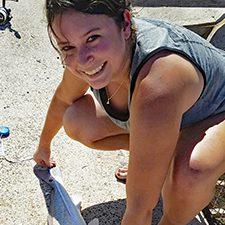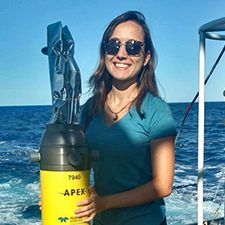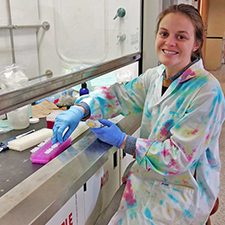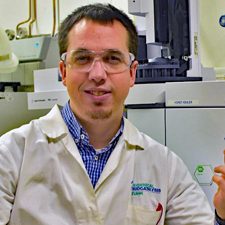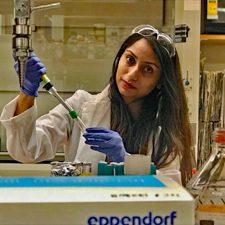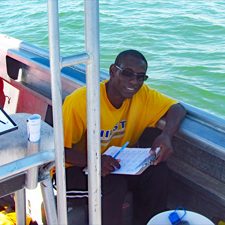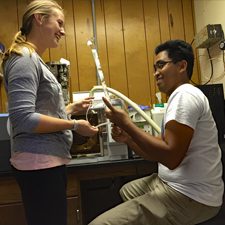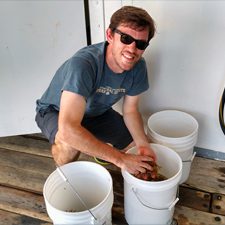The GoMRI Scholars Program recognizes outstanding graduate students and the vital research they contribute to improve understanding about the damage, response, and recovery following the Deepwater Horizon oil spill. The Scholars Program honors and builds community for these next generation of ocean science professionals.
These students serve as essential team members for much of the research underway and bring creativity, curiosity, and energy to the GoMRI scientific program. They represent the successful manifestation of the second GoMRI Legacy Goals, building scientific and intellectual capacity for response and mitigation strategies for future oil spill events.
Candidates for this program must be graduate students who have participated in a GoMRI-funded project for at least one year, whose work is primarily funded by GoMRI, and who are working on a dissertation or thesis based on GoMRI-funded science. On a semi-annual basis, the lead Principal Investigators of GoMRI-funded projects nominate students who meet these criteria.
Following confirmation, each scholar will receive a letter of congratulations declaring the title GoMRI Scholar along with a certificate from Dr. Rita Colwell, GoMRI Research Board Chair. GoMRI will collect information about these scholars and their careers and accomplishments for longitudinal studies and program impacts.
Below are GoMRI Scholars Highlight Stories that have been featured on the web site. For a complete list of scholars, click on the ‘People’ tab for any funded projects to view the list of GoMRI Scholars with affiliation for that project.
Many fish that were exposed to Deepwater Horizon oil survived; however, they may have experienced later-in-life impacts that affected their ability to survive longer than fish that did not experience oil exposure.
During the Deepwater Horizon incident, some models predicted that oil would reach the Florida coastline. However, much of the oil became trapped in cyclonic-like currents, which are eddy flows associated with the Loop Current, and exited the Gulf of Mexico without reaching the Florida coast.
Phytoplankton and bacteria in the northern Gulf of Mexico interact closely at the food web base and provide vital food and nutrients to marine life at higher trophic levels. During the Deepwater Horizon incident, these pervasive organisms played an important role in oil bioremediation before and after the application of chemical dispersants, which broke up surface slicks into smaller droplets and enhanced microbial degradation.
Oil, gases, and bubbles jet out together during a deep-ocean petroleum blowout, and the oil quickly breaks up into different-sized droplets. Predicting the sizes of these droplets is critical to determine how long it will take the oil to reach the ocean’s surface and the resulting oil slick’s size.
When the Deepwater Horizon incident occurred, not much was known about how conditions in the deep sea would affect oil biodegradation. Juan Viamonte uses high-pressure reactors that simulate conditions at depth to observe microbial degradation and help predict what might happen should another deep-ocean oil spill occur.
Following the Deepwater Horizon incident, the National Center for Disaster Preparedness surveyed households in highly-affected areas of Louisiana to track the event’s impacts on the physical and social health of coastal families and their communities.
Petroleum hydrocarbons released by oil spills can accumulate on beaches and in nearshore sediments, potentially creating health risks for humans and coastal organisms. However, the highly variable conditions of beach environments make it difficult to determine the long-term behavior and fate of hydrocarbons in sands and sediment.
Oil spill material that enters the water column may adhere to resuspended seafloor sediments and be transported to other areas. Stephan O’Brien is investigating how physical factors, such as wind and waves, affect the suspension and subsequent transport of sediments in the Mississippi Sound and Bight.
Oil is a complex mixture of chemicals with different degradation behaviors and toxicity levels. Understanding how the compounds in spilled oil, particularly toxic compounds, change with weathering is important to predicting oil’s persistence in the environment.
The deep-pelagic habitat (200 m depth to just above the seabed) is the largest habitat in the Gulf of Mexico, yet we know very little about it compared to coastal and shallow-water habitats.

